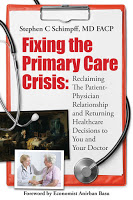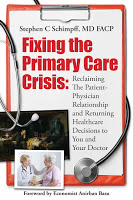The fundamental problem in health care delivery today is a highly dysfunctional payment system that leads to higher costs, lesser quality and reduced satisfaction. It also means less time between doctor and patient with the loss of “relationship medicine.” The core problem? Price controls and regulations that reduce the trust and core interactions between doctor and patient. The patient is no one’s customer and visit times are all too short. I have argued in the Washington Times as an Op-Ed that paying the doctor directly is better for all concerned. I believe that some of the best attempts to improve this dysfunctional delivery system have been accomplished by primary care physicians themselves. They have essentially said “I won’t take it any longer; this is not good for my patients or for me.” They have also said that it is time to “stop tinkering” and make a fundamental change. They have opted for a new, better system – direct primary care – rather than wait for others to fix it for them.
The concept with direct primary care is to reduce the number of patients in a PCPs practice so that each patient gets added time as needed. Often this means removing the insurance system as the payer from primary care and always it means a payment model that compensates the PCP directly by the patient. Direct primary care takes many forms. There are two principle payment systems. One is for the patient to pay the doctor directlyfor each visit, usually at a rate far below what would have been charged in the insurance model since the overheads of billing and coding have been eliminated. Many such PCPs post a defined price list – transparency. This is sometimes called direct pay or “pay at the door,” not unlike the way it was until a few decades ago before insurance morphed from being only for major medical or catastrophic issues to being essentially prepaid medical care.
The second model is for the patient to purchase a package of care for the year paid by the month or annually. This basic model comes with many variations and may be called membership, retainer or concierge. Despite the various names, they all have certain characteristics in common but there are many variations in how the practice functions.
All of these models offer a reduced patient to doctor ratio: instead of the typical 2500-3000+ patient panels, the PCP may adjust the number of patients to a low of 300 when the panel is very ill or to a high of about 800 for a panel that has mostly low risk patients. Some accept insurance and also charge the retainer; others just charge the monthly or annual fee.
With a reduced patient panel size, the PCP commits to offering same or next day appointments lasting as long as necessary, a comprehensive annual examination, email communications, and an invitation to contact the PCP on his or her personal cell phone 24/7. Some make house calls and nursing home visits for no extra charge; others add a modest fee. Some see their patients in the ER and some follow their patients in the hospital.
There may be an arrangement to obtain laboratory testing, imaging and procedures at highly discounted rates from selected vendors. Some practices offer a limited number of laboratory tests at no charge. Some PCPs are supplying medications at no or wholesale costs. For the patient on multiple prescription medications, the savings on drugs can more than offset the monthly/annual subscription cost of direct primary care.
Many only work with specialists who are willing to discount their fees for those of their patients who pay cash and have high deductible plans or no insurance at all.
Often regarded as highly expensive and only for the “elite,” the rich, or the “one percent,” in fact membership/retainer/concierge practices can be of quite reasonable cost and very appropriate for those with no or limited insurance and for those with modest incomes – “blue collar” concierge medicine. Fees range from about $500 to $2000 or more per person per year. [I will ignore those doctors who charge a very high fee for “exclusive” services.] By some degree of common usage those on the lower price end often refer to their practices as direct primary care or membership whereas those at the higher end often refer to their practices as retainer or concierge. To the extent that there is any real difference, it is probably in the number of patients in the panel or seen per day, the extent of the annual evaluation and added values such as following one’s patients in the hospital and in the ER.
For those who have high deductible insurance policies from work or from the exchanges, connecting with a direct primary care physician can offer a significant savings. The individual and the physician now have a direct professional business relationship. The person begins to take a much more active role in the entire care process. And the doctor can allot meaningful time for patient interaction – a return to “relationship medicine.” With little to hope that government or insurers will improve the lot of primary care physicians, direct primary care is a rational manner for PCPs to change the paradigm and return to relationship medicine. It means better medical care, less frustration and more satisfaction for doctor and patient alike and an encouragement to medical students to consider primary care as a career option. It also means that total medical care costs go down. A triple win.









